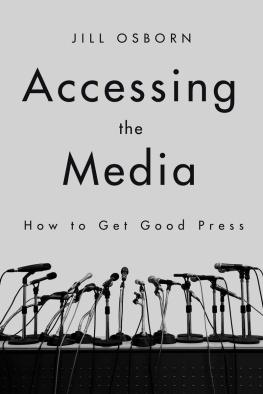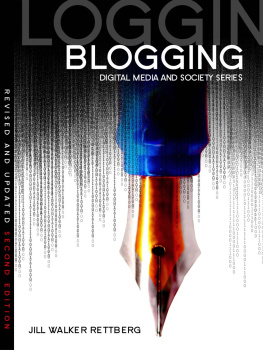
Adolescents and Their Social Media Narratives
Adolescents are forging a new path to self-development, taking advantage of the technology at their fingertips to produce desired results.
In Adolescents and Their Social Media Narratives, Walsh specifically explores how social media impacts teenagers personal development. Indeed, through unique empirical data, Walsh presents an aspect of teen media use that is not often documented in the pressthe seemingly deep and meaningful process of evaluating the self visually in an attempt to reconcile their presentation with their internal self-story. Nevertheless, as Walsh outlines, this is not a process without its challenges.
Tracking teenagers progress towards self-validation from the offline stages preceding online exhibitions, this enlightening volume will appeal to undergraduate and postgraduate students, scholars, and researchers interested in fields such as Social Media Studies, Sociology of Adolescence, Identity Formation, Developmental Psychology, and Society and Technology.
Jill Walsh is a Social Media and Education Consultant and Lecturer in Sociology at Boston University.
Routledge Studies in Science, Technology and Society
www.routledge.com/Routledge-Studies-in-Science-Technology-and-Society/book-series/SE0054
| 28 | Transparency and Surveillance as Sociotechnical Accountability |
| A House of Mirrors |
| Edited by Deborah G. Johnson and Priscilla M. Regan |
| 29 | The Fukushima Effect |
| A New Geopolitical Terrain |
| Edited by Richard Hindmarsh and Rebecca Priestley |
| 30 | Digitizing Identities |
| Doing Identity in a Networked World |
| Edited by Irma van der Ploeg and Jason Pridmore |
| 31 | The Globalization of American Infrastructure |
| The Shipping Container and Freight Transportation |
| Matthew Heins |
| 32 | Science, Risk, and Policy |
| Andrew J. Knight |
| 33 | The Ethics of Ordinary Technology |
| Michel Puech |
| 34 | Imagined Futures in Science, Technology and Society |
| Edited by Gert Verschraegen, Frdric Vandermoere, Luc Braeckmans and Barbara Segaert |
| 35 | Adolescents and Their Social Media Narratives |
| A Digital Coming of Age |
| Jill Walsh |
Adolescents and Their Social Media Narratives
A Digital Coming of Age
Jill Walsh
First published 2018
by Routledge
2 Park Square, Milton Park, Abingdon, Oxon OX14 4RN
and by Routledge
711 Third Avenue, New York, NY 10017
Routledge is an imprint of the Taylor & Francis Group, an informa business
2018 Jill Walsh
The right of Jill Walsh to be identified as author of this work has been asserted by her in accordance with sections 77 and 78 of the Copyright, Designs and Patents Act 1988.
All rights reserved. No part of this book may be reprinted or reproduced or utilised in any form or by any electronic, mechanical, or other means, now known or hereafter invented, including photocopying and recording, or in any information storage or retrieval system, without permission in writing from the publishers.
Trademark notice: Product or corporate names may be trademarks or registered trademarks, and are used only for identification and explanation without intent to infringe.
British Library Cataloguing-in-Publication Data
A catalogue record for this book is available from the British Library
Library of Congress Cataloging-in-Publication Data
A catalog record for this book has been requested
ISBN: 978-1-138-67981-8 (hbk)
ISBN: 978-1-315-54465-6 (ebk)
Typeset in Times New Roman
by Apex CoVantage, LLC
To my wonderful children Ben and Maeve, who will know more about this topic than I ever will. I cant wait for them to teach me! And to Rob, whose love and continued support has carried me on this journey.
To the amazing Dr. Patricia Rieker, whose humor, cheerleading, and deep insights were invaluable resources and greatly improved this work.
In the childrens book Olivia (Falconer 2000), Olivia the pig and her family visit an art museum, and after looking at a Jackson Pollock painting, with its swirls and splatters of color, Olivia declares, I could do that in about five minutes. She goes home and actually tries to recreate the painting on the wall, which lands her in a time-out. Olivia really believes it cannot be that hard to paint like Jackson Pollock. One reason this scene is funny is that many of us secretly (or not so secretly) share Olivias sentiment about modern art: it just looks so easyall you have to do is drip paint or make lines on a canvas. How hard can it be?
Often in modern art, the finished product does not convey the artists behind-the-scenes work to develop the piece. Pollocks paintings, which may appear effortless or easy, are in reality quite thoughtfully created. I start with this brief detour into childrens literature because I thought of Olivias comments about modern art often in the course of researching this project, which started as an in-depth study to hear, in adolescents own words, what the images they post on social media mean to them. And when I first began looking at their images, I honestly had to agree with Olivia. After scrolling through too many bikini pictures, party photos, duck face selfies,1 and clichd moments of adolescence (in particular those that highlight the social hierarchies and gender conformity that have been so well documented in the literature and in popular culture), it all just seemed so superficial, conforming, thoughtless, and even narcissistic. Although my reaction was different, my sentiment echoed Olivias: What is of value here? Where is the substance?
But then I met with teens individually to talk about their images, their decision-making processes, and their motivations for posting the pictures, and I came to realize that the images I was dismissing were really important to them. Initially I was far too focused on my judgment of the end productthe image itselfand had no appreciation for how much time and thought they give to their social media images. These are not just pictures; these are tools they use to communicate with others and with themselves. And images are a really interesting medium through which teens can communicate, as they are a way of telling ones own experience (Radley and Bell 2007: 369) visually. Thus we can use these images as data to understand the individual (Radley and Bell 2007; Bell 2010). For teens, creating and curating images means simultaneously considering a dual audiencethe images are both for the self and for their broader social media audience. For almost all of the teens in the study, these images served to affirm their sense of self. When they create and curate images they assess themselves, evaluate how others will judge them, and then form some opinion about what they see and what it may signal about them.
Herein lies some of the appeal for teens. Adolescence is a period in which we know that the self is in flux, and yet in the midst of this evolution, answering the question who am I might be considered one of the most important tasks of adolescent development (Erikson 1980). In an interesting way social media offers an opportunity for teens to try to answer this, and other questions, by serving as a platform through which the developing self can be seen and judged by both the individual and the broader social audience. Looking at only their posted images misses this because the evaluative work is invisible to a Facebook audience simply scrolling through picture after picture. Yet it is a critical component of their investmentboth in terms of time and emotionon social media. As a result, the effort they employ to create and curate images must be considered as an important part of their social media experience. Observing the bikini picture a teen posts is one thing; understanding how that picture came to be, why it was selected, how she might interpret feedback on the image, and ultimately what it might mean for her is another. In my work, I came to understand that the significance of the images is usually not as obvious, effortless, or straightforward as it may seem. Although, to be sure, this is not the case 100 percent of the time; sometimes a bikini picture is just a bikini picture.












